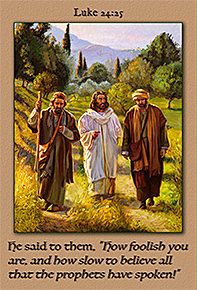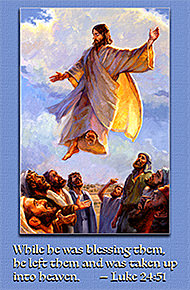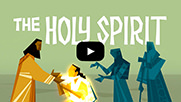Luke 24:36–53 . . . Bible Study Summary with Videos and Questions
An Amazing Apparition and Ascension
Some news seems too good to be true; often, it’s not true. Whether to protect ourselves from disappointment, or because it happens so rarely, we’re prone to disbelieve really good news. Even so, the disciples were prone to doubt the reports that Jesus was risen from the dead. First, women came and told them that the tomb was empty and that they’d seen the risen Lord Jesus. “Their words seemed to them like nonsense” (24:11). Then, Peter and John went and looked into the empty tomb. Peter left marveling, but not yet believing. Then the Lord appeared to two men on the road to Emmaus (shown here). Later on that first post-resurrection Sunday, both burst into the room where the disciples were gathered and excitedly told everyone about their encounter with the Lord. But the apostles didn’t at first believe these men. Maybe they were thinking, Why would the Lord appear to them? They aren’t even apostles! They must have just seen a vision! Sometime during that day, the Lord had appeared to Peter, forgiving and restoring him, but the others still hadn’t seen the Lord firsthand and still doubted.
Then, while they were still discussing these strange happenings, the Lord himself stood in their midst. He hadn’t opened the door! They thought that they were seeing a ghost, but he was no ghost. He was the risen Lord Jesus who greeted them with words of comfort, gently rebuked their doubts, and offered them assurances to strengthen their faith. But even so, “they still did not believe it because of joy and amazement” (v. 41). It just seemed too good to be true. But it was true, and they needed to believe it. This first resurrection appearance of Christ to the whole group of disciples except Thomas (John 20:19–24) ought to teach us this: Though we are prone to unbelief, and though Christ’s death and resurrection on our behalf seems too good to be true, it’s all true and we must believe it.
This superb animated video comes compliments of BibleProject
Three-Part Structure of Our Text
Verses 36–43 depict the unbelief of the disciples while they emphasize the “physical evidence” for the resurrection of the Lord Jesus Christ. Verses 44–49 deal with the “biblical evidence” for what had taken place, and for what was yet to happen. And, vv. 50–53 describe our Lord’s ascension (shown here) and the dramatic difference that these events had had on how boldly and differently the disciples were to worship Christ.
Part 1: The Physical Evidence (v. 36–43)
... gospelimages.com

Click to enlarge and download this
contemporary painting that depicts the
Luke 24:25 story of resurrected Jesus’
walking with two of his disciples.
The physical evidence of Jesus’ resurrection is exhibited in part 1 of today’s concluding text of Luke’s detailed gospel. The two disciples whom Jesus intercepted on the road to Emmaus (shown left and presented in last week’s summary of 24:13–35) couldn’t wait to return to tell the good news to their brethren in Jerusalem. Immediately after they’d recognized Jesus and he disappeared, they rushed back to the disciples. But they weren’t able to get their words out because Jesus had already appeared to Peter, who later told them that Jesus was indeed alive. Thus, the two disciples first heard of the certainty of Jesus’ resurrection from their peers. The best they could do now was simply to add their own testimony to the same truth that Jesus had really risen from the dead and they believed it.
Or so it seemed. But when Jesus actually appeared, it was clear that their “belief” in his resurrection was insufficient. Jesus’ first words to this group were, “Peace be with you” (v. 36), however, they didn’t respond in peace. They were “startled and frightened,” Luke tells us (v. 37).
Why weren’t they overjoyed? The Greek for “startled” suggests that the disciples were “caught off guard,” as though they never expected to see Jesus. If he was really alive, as they professed, why would his appearance be such a shock? If Jesus had greeted everyone with a “peace” pronouncement, why were they troubled? Apparently, the disciples believed in ghosts and thought Jesus to be one.
The thrust of vv. 36–43 is our Lord’s gracious provision of ample physical evidence for his resurrection. The first evidence was the Lord, standing before them. He wasn’t, as they supposed, a ghost. He encouraged them to touch him to see that he had flesh and bones; he also encouraged them to look at his hands and feet (v. 40), inferring that his hands and feet bore the nail prints from his crucifixion.
Finally, Jesus ate broiled fish that they were eating, which proved that his body was, indeed, a real one. Otherwise, how would Jesus be able to share a banquet with his disciples in heaven, and to drink the cup and eat the bread anew in the kingdom (cf. 22:15–18)?
The evidence was compelling. The disciples were convinced, as is most apparent by their change in disposition. Luke provides three pairs of descriptions on which to reflect: (1) Startled and Frightened (v. 37); (2) Troubled and Doubting (v. 38); (3) Joy and Amazement (v. 41). The disciples’ first response to Jesus’ appearance was that they were “startled and frightened.” Jesus pressed past those symptoms to the deeper roots being that their spirits were “troubled and doubting.” Once the evidence was grasped by the disciples, their troubled spirits became “joy-filled” while their “doubt” turned to “amazement.” Their former “doubt” was that of unbelief, however, the latter “amazement” was due to joy through the disciples’ firm belief.
Part 2: The Biblical Evidence (v. 44–49)
With the two disciples on route to Emmaus, Jesus had begun to present biblical evidence concerning his rejection, suffering, death, and resurrection. Then he was revealed to them, only to immediately disappear. Now in part 2, that order is reversed, but both evidential elements are present. There’s nothing “new” here as to what’s happened to the Lord Jesus or what was to take place in and through the disciples. All this had been prophesied in the Scriptures and foretold by Jesus. There are three specific areas of focus here: (1) Jesus’ rejection, suffering, death, and resurrection; (2) the gospel’s proclamation to all nations; and (3) the promise of the Holy Spirit to empower the disciples.
The first of these three shouldn’t surprise us. The rejection, death, and resurrection of Messiah was one of the prominent prophetic themes of the Old Testament. Jesus’ rejection and suffering was alluded to by Simeon (Luke 2:34–35); it was hinted at by the treatment of John the Baptist, the forerunner of Jesus; it was anticipated at Jesus’ rejection on the occasion of his first recorded public presentation of himself as Messiah in the synagogue at Nazareth (4:14–30). As Jesus’ ministry and message became more widespread, opposition of Jewish religious leaders became more intense and organized. On several occasions, our Lord told his disciples that this would be his divinely determined destiny (cf. Luke 9:21–23, 44–45; 18:31–34). While the disciples didn’t grasp this truth, even resisting what they knew of it, they needed only to be reminded that this was what he’d told them.
Jesus’ rejection, suffering, death, and resurrection wasn’t only something he’d told them previously, on a number of occasions, it was also what Old Testament prophets had foretold, beginning with the Law of Moses and including the Prophets and the Psalms, which weren’t mere references to general witnessing to Messiah’s suffering; they were the three main categories or divisions into which the entire Old Testament had been sub-divided. Thus, Jesus was reminding his disciples that the entire Old Testament — all three major divisions — had born witness to his suffering and death.
Twice now, in the last chapter of Luke’s gospel, Jesus had made reference to Old Testament prophecies referring to his rejection, suffering, death, and resurrection. At least in his conversation with the two men on the road to Emmaus (24:13–35), Jesus specifically referred to a number of Old Testament texts, and he explained them in light of their fulfillment in him. Alas, we’re not given so much as one reference in today’s passage. Likely, God intended for us hearty disciples to search out these texts for ourselves.
In v. 45, Luke informs us that Jesus removed a veil, enabling the disciples to understand Old Testament Scriptures, for the first time, pertaining to him being the Messiah, especially as related to his rejection, suffering, and death. It wasn’t until after his resurrection that the eyes of the disciples were opened to understand all that the prophets had spoken pertaining to the ministry of the Messiah, especially of his rejection, suffering, death, and resurrection. That veil was removed. From that point on, the disciples were to turn to Old Testament prophecies to prove that Jesus was the promised Messiah, and that all that had happened to him was a prophetic necessity.
The second facet of Old Testament prophecy to which Jesus pointed the disciples was the proclamation of the gospel to all nations, not just to Israel (vv. 46–48): “The Messiah will suffer and rise from the dead on the third day.” How the Jews must have resisted this aspect of Christ’s Messiah-ship, i.e., that the non-Jewish Gentiles would receive salvation. The universality of the gospel — the fact that Messiah would die for the sins of all who’d believe in him, whether Jew or Gentile — was one of the greatest irritations for the Jews, especially for those who didn’t see themselves as being “sinners.”
In the light of the fact that the salvation that Messiah came to bring was for all nations, the Great Commission should come to us as no new revelation, rather as an outflow, both of the work of Christ on the cross of Calvary and of the Old Testament prophecies that foretold the salvation of men of every nation. Notice that Luke (both here and in Acts 1:8) records the Great Commission not so much as a command but as a promise and a certainty.
As we come to the third element of biblical evidence — the promise of the Holy Spirit to empower disciples — in order for the gospel to be proclaimed to men of every nation, beginning at Jerusalem, the disciples had to have been empowered, as promised, by the Holy Spirit, which was to turn hearts of stone to hearts of flesh, thereby convicting and converting some of those who, only a little more than a month before, had called for Messiah’s murder. This promise of the Holy Spirit was, like the two previous elements of prophecy, something that Jesus had spoken of to his disciples, and which the Old Testament prophets had foretold.
The coming of the Holy Spirit was “clothed with power from on high,” as Jesus said (v. 49). He commanded his disciples not to go forth personally witnessing to those things that had happened apart from the power that he’d provide through his Spirit. He who commanded the disciples to be his witnesses also commanded them to witness only in the power that he’d provide. He who commands is he who enables.
Part 3: All Disciples Are to Worship Boldly (v. 50–53)
... gospelimages.com

Click to enlarge and download this
contemporary painting of Luke 24:51
highlighting Jesus’ ascension.
Worshiping Jesus boldly in light of these four closing verses means responding to the risen, ascended Lord with whole-life adoration — heart, words, and actions — all shaped by Scripture. Our worship becomes “bold”because it’s public, joyful, and costly; it’s “appropriate” worship because it remains reverent, obedient, and aligned with what God has revealed.
This final chapter documents that: (1) The disciples worshiped Jesus as he ascended, recognizing him as the divine Lord who completed his saving work and now reigns at the Father’s right hand; (2) their worship immediately flowed into joyful obedience: they returned to Jerusalem — the dangerous city that killed Jesus — because he told them to stay there; and (3) they then “stayed continually at the temple praising God,” so their worship was regular, public, and centered on praising God for what he’d done in Christ.
Forty days will have passed, as Luke makes clear in Acts 1:3. The disciples were led to the outskirts of Jerusalem, a “Sabbath day’s walk” to that city, to Mount Olivet (v. 12). As he lifted his hands in blessing, he was taken up from them. As you’ll see in the closing video clip linked below, those disciples had, days earlier, been so distraught and disarmed by Jesus’ death. Suddenly, they’re described as having been boldly transformed.
Notice the change that Luke describes briefly (vv. 52–52). These once despondent disciples became filled with joyful praise. Jesus’ followers, who’d only days before cowered behind locked doors, hidden from the Jewish religious leaders who crucified their Lord, persistently and publicly praised God in the temple, albeit Judaism’s headquarters.
- Q. 1 Do you have difficulty accepting the news of Jesus’ resurrection and/or ascension?
- Q. 2 How can we experience the Holy Spirit’s power in our lives each day?
- Q. 3 Why is being joyful essential, not optional, for true believers?
Luke 24:36–53 (Lukas)
New International Version (NIV)
[To view it in a different version, click here; also listen to chapter 24.]
† Watch this closing video clip from Jesus Film Project titled “Great Commission and Ascension.”
Jesus Appears to the Disciples
36While they were still talking about this, Jesus himself stood among them and said to them, “Peace be with you.”
37They were startled and frightened, thinking they saw a ghost. 38He said to them, “Why are you troubled, and why do doubts rise in your minds? 39Look at my hands and my feet. It is I myself! Touch me and see; a ghost does not have flesh and bones, as you see I have.”
40When he had said this, he showed them his hands and feet. 41And while they still did not believe it because of joy and amazement, he asked them, “Do you have anything here to eat?” 42They gave him a piece of broiled fish, 43and he took it and ate it in their presence.
44He said to them, “This is what I told you while I was still with you: Everything must be fulfilled that is written about me in the Law of Moses, the Prophets and the Psalms.”
45Then he opened their minds so they could understand the Scriptures. 46He told them, “This is what is written: The Messiah will suffer and rise from the dead on the third day, 47and repentance for the forgiveness of sins will be preached in his name to all nations, beginning at Jerusalem. 48You are witnesses of these things. 49I am going to send you what my Father has promised; but stay in the city until you have been clothed with power from on high.”
The Ascension of Jesus
50When he had led them out to the vicinity of Bethany, he lifted up his hands and blessed them. 51While he was blessing them, he left them and was taken up into heaven. 52Then they worshiped him and returned to Jerusalem with great joy. 53And they stayed continually at the temple, praising God.
